| |

Traditions, folklore, history and more. If it's Irish, it's here. Or will be!
"People will not look forward to posterity who never look backward to their ancestors."
-Edmund Burke




Quotes
Library: Books, Movies, Music
Prints & Photos
Poetry
Jokes


Shops Ireland
Bunús na Gaeilge
(Basic Irish)
Circle of Prayer
Blessings
Did You Know?
Himself/Herself
Write to Us
Readers Write..
Links/Link to Us
Advertise with us
Awards & Testimonials
Submissions Guide

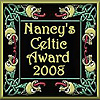
|
|
|
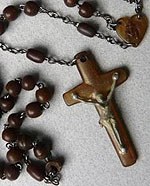 Irish Horn Rosaries Irish Horn Rosaries
by Shellay Maughan
The rosary’s history in Ireland is long and sometimes problematic. Misinformation about rosaries such as the ‘Penal Rosary’ and the ‘Irish Horn Rosary’ is common, especially online. In addition, the dark history of laws against Catholics, and abusive labor practices within the church, shadows the history of the rosary in Ireland. Yet devotion to the rosary as a symbol of Catholic identity is stronger in Ireland than perhaps anywhere else in the world, as shown by the many beautiful, distinctively Irish styles and materials.
Rosaries with beads made from horn were made in Ireland from the mid 1800s into the 1960s. They were an authentic traditional craft, and even in the 20th century they were mostly handcrafted. While horn is a resilient material in many ways, standing up well to daily use and nearly unbreakable, it can be destroyed by exposure to the elements. Mice love to eat these beads. As a result only a small fraction of the many horn rosaries that were produced still exist today, and they are highly sought after by collectors.
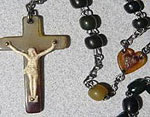  Most horn rosaries have heart shaped centers, but occasionally you'll see a harp or Miraculous Medal. Rosaries from the ‘50s usually have hollow Lucite centers in the shape of a heart, containing holy water, and amber colored Lucite crosses with a white Lucite corpus. Earlier versions have celluloid crosses - these are often warped as celluloid isn't very stable. The oldest have flat centers made from horn, and horn crosses with a metal corpus. More expensive versions have silver centers and crucifixes, and/or silver bead caps on the paters. You'll see different combinations of these materials and styles, so this is a generalization, but the horn beads themselves are the identifying mark of an Irish Horn rosary. The beads are often dyed red, yellow, or green, sometimes bleached white, and sometimes are a combination of colors. If left natural, the horn is a warm dark beige color. Most horn rosaries have heart shaped centers, but occasionally you'll see a harp or Miraculous Medal. Rosaries from the ‘50s usually have hollow Lucite centers in the shape of a heart, containing holy water, and amber colored Lucite crosses with a white Lucite corpus. Earlier versions have celluloid crosses - these are often warped as celluloid isn't very stable. The oldest have flat centers made from horn, and horn crosses with a metal corpus. More expensive versions have silver centers and crucifixes, and/or silver bead caps on the paters. You'll see different combinations of these materials and styles, so this is a generalization, but the horn beads themselves are the identifying mark of an Irish Horn rosary. The beads are often dyed red, yellow, or green, sometimes bleached white, and sometimes are a combination of colors. If left natural, the horn is a warm dark beige color.
Another way of dating horn rosaries from Ireland is to look at the Country of Origin stamp on the back of the crucifix. Ireland's official name changed often in the early part of the 20th century and the name stamped into the cross will give you a good idea of when it was made.
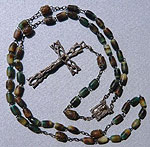 Mitchell's Rosary Bead Factory of Dublin Mitchell's Rosary Bead Factory of Dublin
Beads made from horn aren’t limited to Ireland, but they are surprisingly rare elsewhere. They are closely linked to the Mitchell Rosary Factory of Dublin; the earliest printed reference I’ve found to rosaries made of horn beads is from a report on handicrafts in Dublin, published in 1908. In this publication, the Mitchell family is mentioned as drawing on their family business making combs and other ornaments from horn, bringing this expertise to the making of horn rosary beads: "There is one Irish policy about which everybody is agreed, namely, the development of Irish industries; and this is the policy of the Irish Art Companions. In 1904 they set to work, taking a house, a workshop, and show-room at Nos. 27 and 28 Clare Street, Dublin. Besides the crafts of modeling and casting, the Companions make rosary-beads and other articles from horn; and for this purpose they have allied with themselves Mr. Albert Mitchell, the son of the last of many Irish by-gone comb-makers." [1]
In his memoir ‘It’s a Long Way from Penny Apples’, Bill Cullen gives us a fascinating, and largely positive, look at Mitchell’s rosary factory in the 1950s:
“Alex Mitchell’s rosary-bead factory had hundred of girls making rosary beads to help Christians pray all over the world. There was a terrible smell from the factory when the girls were boiling the cows’ horns. That’s right. Made out of cows’ horns the beads were. The boiling softened the horns so the cutting machine could extract little round balls of horn. Then the spike machine stuck a hole through the middle of the ball. The balls were run through a dying machine. Different color every day. Some left natural. The drying machine hardened the beads. The polishing machine gave them a shiny gloss. The machines in rows worked by the girls, who wore white coveralls with a big loose white hat over their heads to keep the smell of the horns off their hair. Hundreds of colored shiny beads with a hole in the center poured into the collecting vat.
Buckets full of beads were given to the “decade girls,” who lined up at the workbench with their pliers and a roll of fine wire. Thread the wire through the bead, then cut the wire and make a little hook with your pliers. Attach another piece of wire and thread another bead. Cut and hook again. Until you had a string of ten beads. A decade of the Rosary. Drop the decade into your finishing tray and start again. You were paid by the decade… [2]
 In the finishing room, other workers linked the decades together and added the crosses and centers. It appears that all of the factory workers were women, and this hang tag from 1947 seems to agree: In the finishing room, other workers linked the decades together and added the crosses and centers. It appears that all of the factory workers were women, and this hang tag from 1947 seems to agree:
The work was dull, and hurt the workers hands. But in inner-city Dublin any work was a blessing. Mr. Cullen’s description of Alex Mitchell the elder is fond and respectful.
“The work was boring. So the girls gossiped… And they sang. Every song ever written. Taking it in turns, with everyone joining in the chorus. Old man Mitchell was a gentleman. Always smiling. Always stopped to have a word with the girls. Knew most of them. Gave a few pounds’ bonus at Christmas.” [2]
 
Not everyone held as positive a view.
"And what do I know about poor Mother? Precious little. I know that she was Melody Nash. A beautiful name, promising so much. I know that she was born in Dublin and that she lived on Bolton Street. She worked in Mitchell's rosary bead factory on Marlborough Street. They made the beads out of cows' horns. All day, six days a week, sweating, going blind for God and Mitchell. Putting the holes in the beads for Jesus. Hands bleeding, eyes itching. " ~ A Star Called Henry - Roddy Doyle
Besides the regular factory workers, the poor of Dublin could work stringing rosary beads at home, receiving supplies from Mitchells and being paid tuppence for each finished decade they delivered.
“…And every evening Molly’s table became a rosary-bead factory. Cut and hook. Cut and hook. Even with gloves, the pliers and wire cut into your fingers. Cuts and calluses. Everyone had a go at making the rosary beads.” [2]
The style of these rosaries changed a bit over the years, but I have yet to see a vintage Irish horn rosary with a makers mark from any company other than Mitchells.
Horn rosary beads are no longer made in Ireland. I’ve run into many fanciful guesses as to why this is so, but the most likely reason is the smell of the boiling vats. These were a constant source of complaint in the neighborhood and were eventually banned from urban areas, sometime in the early 1960s. The Mitchell family is still in the rosary business though, making their rosaries from Connemara marble, glass, and plastic. Oddly, the family name is still used but the spelling has changed. It doesn't seem to be a typo as this spelling is used on every current Mitchel's tag. 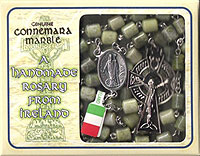 The logo and other information is the same, and I'm confident it's the same company. This rosary and box were made in the first decade of the 21st century: The logo and other information is the same, and I'm confident it's the same company. This rosary and box were made in the first decade of the 21st century:
References
1) Handbook to the city of Dublin and the surrounding district - British Association for the Advancement of Science; 1908 E. A. ilONTMOKENCY MoilRIS, M.A.
2) It’s a Long Way from Penny Apples’, Bill Cullen
~~~~~~~~~~~~~~~~~
Old Irish Rosaries ~ Edward A. McGuire
Published by: The Furrow, Vol. 5, No. 2 (Feb., 1954), pp. 97-104, 1-4, 105 (article consists of 13 pages)
http://www.jstor.org/stable/27656399
~~~~~~~~~~~~~~~~~~~~~~`
The Goldenbridge Secret Rosary Bead Factory ~ Marie-Therese O'Loughlin Dec 27th, 2006
http://www.butterfliesandwheels.org/2006/the-goldenbridge-secret-rosary-bead-factory/
~~~~~~~~~~~~~~~~~~~~~~~~~~~
Haunted by Irish rosary beads ~ James Carroll
Reprinted in full with the kind permission of Shellay Maughan, owner and designer of The Jeweled Rose web site which is dedicated to the study and appreciation of vintage and antique prayer beads.
Her home page is here: Jeweled Rose
http://jeweledrose.com/types/types_michells.htm
|
|
Fri, Sep 27, 2024
 The Galway Hooker The Galway Hooker
This unique vessel, with its distinctive curved lines and bright red sails, originated in the village of Claddagh. During the 19th century, hookers supported a significant fishing industry and also carried goods, livestock and fuel. Seán Rainey is remembered for building the last of the original boats, the Truelight, for Martin Oliver who was to become the last king of the Claddagh; as king, he was entitled to white sails on his boat. Since the mid seventies, many of the old sailing craft which were on the verge of extinction have been lovingly restored and new ones have been built. During the summer months they can be seen at festivals such a Cruinniú na mBád - the Gathering of the Boats - in Kinvara.
Click for More Culture Corner.
Traditional Damask brings you a world of grace and charm evolved over the centuries. This exqusite Fingal cloth with inherent lustre, smooth hand and long life, is the product of skills and methods unchanged through generations. Matching napkins also available.
Click here for Linen Tablecloths and napkins.
|
|
|
|
|




 The Galway Hooker
The Galway Hooker